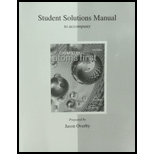
Concept explainers
Interpretation:
The pressure of the gas calculated using the ideal gas equation and the van der Waals equation has to be explained.
Concept introduction:
Ideal gas is the most usually used form of the ideal gas equation, which describes the relationship among the four variables
Van der Waals equation:
We find the pressure by first solving algebraically for
Answer to Problem 10PPB
(a)
The pressure of the gas calculated using the ideal gas equation is
(b)
The pressure of the gas calculated using the van der Waals equation is
Explanation of Solution
(a)
To determine: The pressure of the gas calculated using the ideal gas equation
The pressure of the gas calculated using the ideal gas equation is calculated below
Given,
Where
The pressure of the gas calculated using the ideal gas equation is
(b)
To determine: The pressure of the gas calculated using the van der Waals equation
The pressure of the gas calculated using the van der Waals equation is calculated below
Given,
Where
Evaluating the correction terms in the van der Waals equation, we get
The pressure of the gas calculated using the van der Waals equation is
The pressure of the gas calculated using the ideal gas equation and the van der Waals equation was explained.
Want to see more full solutions like this?
Chapter 11 Solutions
Student Solutions Manual For Chemistry: Atoms First
- Calculate the Boyle temperatures for carbon dioxide, oxygen, and nitrogen using the van der Waals constants in Table 1.6. How close do they come to the experimental values from Table 1.5?arrow_forwardIn the text, it is stated that the pressure of 4.00 mol of Cl2 in a 4.00-L tank at 100.0 C should be 26.0 atm if calculated using the van der Waals equation. Verify this result, and compare it with the pressure predicted by the ideal gas law.arrow_forwardUnder what conditions does the behavior of a real gas begin to differ significantly from the ideal gas law?arrow_forward
- The barometric pressure measured outside an airplane at 9 km (30,000 ft) was 266 torr. Calculate the pressure in kPa.arrow_forwardSF6 is a gas at room temperature, 295K. What is its root-mean-square speed at that temperature?arrow_forwardA 275-mL sample of CO gas is collected over water at 31C and 755 mmHg. If the temperature of the gas collection apparatus rises to 39C, what is the new volume of the sample? Assume that the barometric pressure does not change.arrow_forward
 Chemistry: The Molecular ScienceChemistryISBN:9781285199047Author:John W. Moore, Conrad L. StanitskiPublisher:Cengage Learning
Chemistry: The Molecular ScienceChemistryISBN:9781285199047Author:John W. Moore, Conrad L. StanitskiPublisher:Cengage Learning Chemistry: Principles and PracticeChemistryISBN:9780534420123Author:Daniel L. Reger, Scott R. Goode, David W. Ball, Edward MercerPublisher:Cengage Learning
Chemistry: Principles and PracticeChemistryISBN:9780534420123Author:Daniel L. Reger, Scott R. Goode, David W. Ball, Edward MercerPublisher:Cengage Learning Physical ChemistryChemistryISBN:9781133958437Author:Ball, David W. (david Warren), BAER, TomasPublisher:Wadsworth Cengage Learning,
Physical ChemistryChemistryISBN:9781133958437Author:Ball, David W. (david Warren), BAER, TomasPublisher:Wadsworth Cengage Learning, Chemistry & Chemical ReactivityChemistryISBN:9781337399074Author:John C. Kotz, Paul M. Treichel, John Townsend, David TreichelPublisher:Cengage Learning
Chemistry & Chemical ReactivityChemistryISBN:9781337399074Author:John C. Kotz, Paul M. Treichel, John Townsend, David TreichelPublisher:Cengage Learning Chemistry & Chemical ReactivityChemistryISBN:9781133949640Author:John C. Kotz, Paul M. Treichel, John Townsend, David TreichelPublisher:Cengage Learning
Chemistry & Chemical ReactivityChemistryISBN:9781133949640Author:John C. Kotz, Paul M. Treichel, John Townsend, David TreichelPublisher:Cengage Learning Introductory Chemistry: An Active Learning Approa...ChemistryISBN:9781305079250Author:Mark S. Cracolice, Ed PetersPublisher:Cengage Learning
Introductory Chemistry: An Active Learning Approa...ChemistryISBN:9781305079250Author:Mark S. Cracolice, Ed PetersPublisher:Cengage Learning





